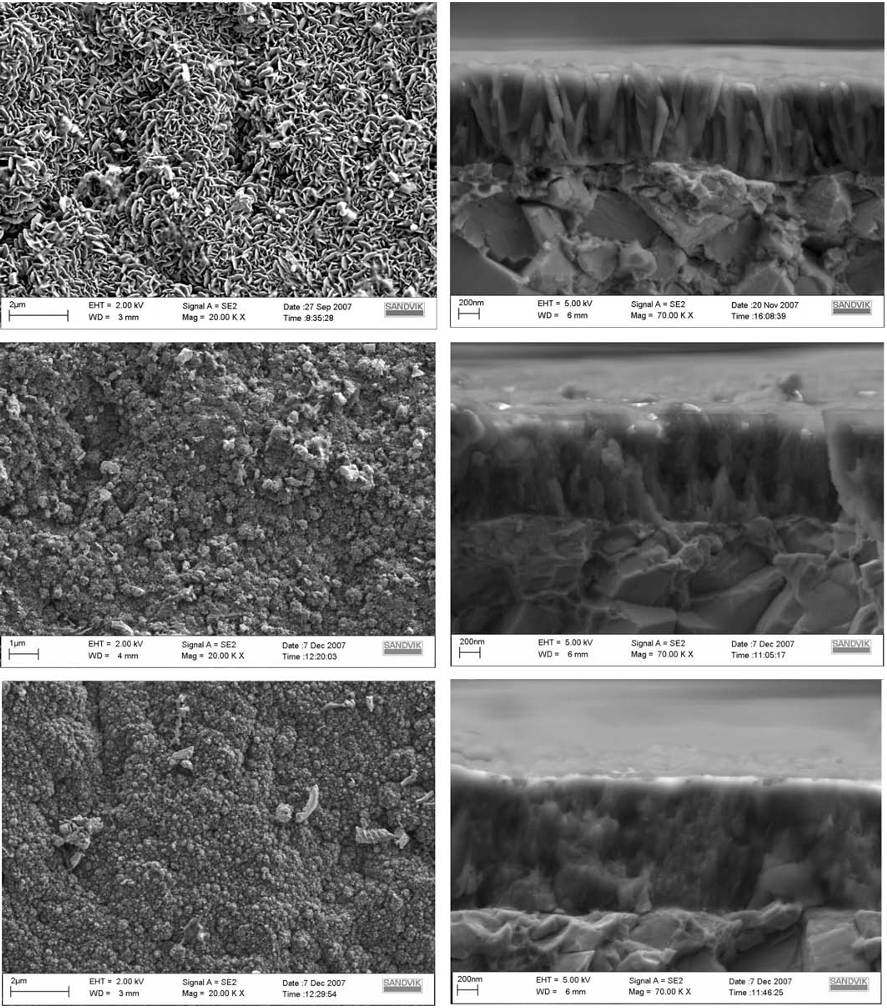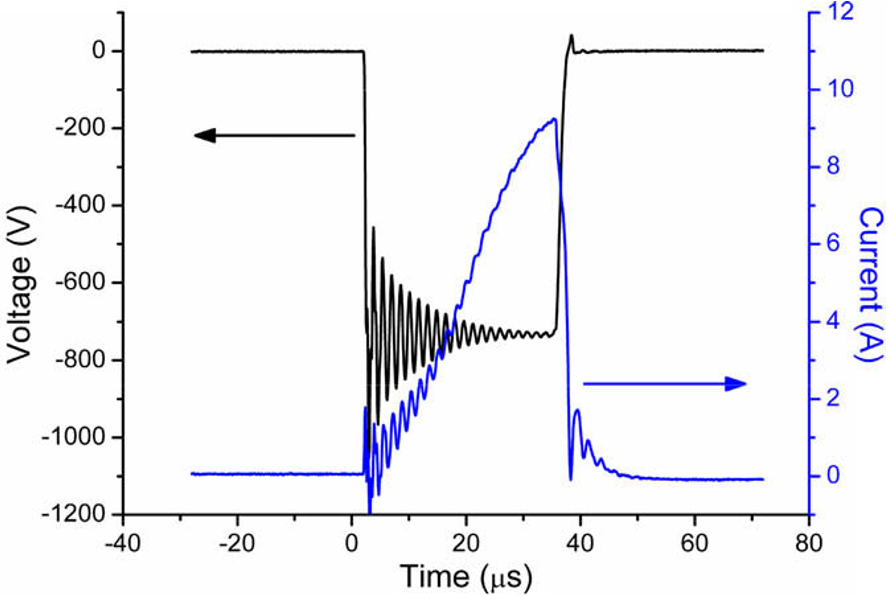
Linköping University Post Print
α-alumina coatings on WC/Co substrates by
physical vapor deposition
T.I. Selinder, E. Coronel, Erik Wallin and Ulf Helmersson
N.B.: When citing this work, cite the original article.
Original Publication:
T.I. Selinder, E. Coronel, Erik Wallin and Ulf Helmersson, α-alumina coatings on WC/Co
substrates by physical vapor deposition, 2009, International journal of refractory metals
& hard materials, (27), 2, 507-512.
http://dx.doi.org/10.1016/j.ijrmhm.2008.10.007
Copyright: Elsevier Science B.V., Amsterdam.
http://www.elsevier.com/
Postprint available at: Linköping University Electronic Press
http://urn.kb.se/resolve?urn=urn:nbn:se:liu:diva-15359

α-ALUMINA COATINGS ON WC/Co SUBSTRATES BY PHYSICAL VAPOR
DEPOSITION
T.I. Selinder*, E. Coronel*, E. Wallin**, U. Helmersson**
*Sandvik Tooling, SE-126 80 Stockholm, Sweden
**Plasma and Coatings Physics Division, IFM Material Physics, Linköping University,
SE-581 83 Linköping, Sweden
Abstract
Physical vapor deposition coatings for cutting tools may be deposited by, e.g. reactive
magnetron sputtering. Alumina growth in Ar/O
2
gas mixtures gives rise to problems due
to insulating layers on targets, and hysteresis effects with respect to oxygen gas flow. In
this paper is described a technology for the deposition of crystalline alumina: reactive
high power impulse magnetron sputtering. Pure Al was used as target material, and the
cemented carbide (WC/Co) substrates were kept at 500-650ºC. Hysteresis effects with
respect to oxygen gas flow were alleviated, which enabled stable growth at a high
deposition rate. The high power impulses were helpful in obtaining a crystalline oxide
coating. X-ray diffraction and cross-section transmission electron microscopy showed
that α-alumina films were formed. Technological testing of these PVD alumina
coatings, with state-of-the-art AlTiN as benchmark, showed significantly improved
crater wear resistance in steel turning.
Keywords: HiPIMS, HPPMS, ionized-PVD, alumina, corundum
Page 1 of 18

Introduction
Hard physical vapor deposited (PVD) coatings may be coated by a variety of methods,
e.g. direct current (DC) magnetron sputtering in Ar inert gas. Reactive sputtering in
Ar/oxygen gas mixtures, may be used to grow oxides, but for insulators, in particular
alumina, this gives rise to problems due to the formation of insulating layers.
Conducting surfaces are a prerequisite to sustain an electrical glow discharge in DC
mode. These problems are circumvented in the bipolar pulsed magnetron technique
(BPDMS) [1-2], in which two magnetrons work in pair, alternating as anode and
sputtering target. By using pulse frequencies in the range of a few kHz the Al erosion
rate exceeds the rate of oxide formation at each target surface. Albeit stable, BPDMS
has only been repeatedly successful in depositing γ-alumina, which is a drawback if
phase stability of the coating is of concern. So far, commercial α-alumina coatings have
only been grown by chemical vapor deposition (CVD) at relatively high substrate
temperatures. In order to coat heat sensitive substrates, e.g. polycrystalline c-BN, high
speed steel, brazed tools, etc. the process temperature needs to be reduced. For this and
other reasons research and development on PVD alumina by, for instance, dual
magnetron sputtering [3], and arc evaporation [4] has been intense for the past few
years. Preoxidation of Cr-containing surfaces have enabled nucleation and growth of α-
alumina [5], but still requires substrate temperatures of 700-750ºC. A commercial
technology capable of growing highly crystalline mixed oxides (Al,Cr)
2
O
3
by the arc
method at temperatures below 600ºC were recently made available on the market [6],
but the commercialization of pure PVD α-alumina still remains. In this context the
novel technology high power impulse magnetron sputtering (HiPIMS) [7,8]have been
studied because this intermittent very high energetic sputtering technique widens the
Page 2 of 18

possibilities of supplying energy to the growth surface, which likely is the key to
success in nucleating α-alumina, and sustaining its growth. The HiPIMS technique has
been studied for deposition of both conducting coatings [9] as well as for oxide coatings
[10-11]. The degree of ionization of the sputtered material may be higher than for
traditional sputtering but the ionized species also accelerate towards the target, so-called
self sputtering, that has a lower sputtering yield than that of Ar sputtering. Therefore
one drawback with HiPIMS has been the inherently low growth rate. Recently, it was
shown that high rate sputtering is possible, and that long time stable operation of Ar/O
2
discharges is possible without feedback control of the reactive gas [12]. Stoichiometric
alumina was grown, with a phase structure that was dependent on substrate temperature;
at temperatures as low as 650ºC α-alumina was the only crystalline phase detected by
X-ray diffraction (XRD). Initial transmission electron microscopy (TEM) studies
revealed, however, that γ-alumina may grow, at least during the early stages in film
growth directly on WC/Co. XRD indicates that at the same temperature and identical
growth conditions AlTiN pre-coated substrates tend to favor growth of α- over γ-
alumina. A possible origin of this difference is discussed.
Experimental details
Coatings were made in a laboratory scale ultra-high vacuum system, with a base
pressure of less than 3×10
-5
Pa. A planar, 50mm diameter shuttered magnetron
sputtering source was mounted with a pure (99.999%) 3mm thick Al target. Cemented
carbide, WC10%Co (H10F), substrates were mounted flat on a resistive heater directly
above the magnetron, at a distance of 11 cm. Temperatures during different runs were
maintained at 650, 575, and 500 ºC. In order to grow films on cutting edges ISO style
Page 3 of 18

CNMG120408-MM H10F substrates were mounted, two at a time, on a tilted holder.
One nose and cutting edge was directed towards the magnetron. In this way both the
tool rake and flank faces were coated. In the latter case, however, it is estimated that the
real substrate temperature is approx. 50ºC less than the nominal set value. The
temperature reported herein is always the set nominal temperature, however, not the
estimated temperature. Substrates were either floating, or bias was applied by radio
frequency (RF) by an Advanced Energy RFX-600 power supply.
A fixed 99.997% pure Ar flow was adjusted to establish a pressure of 2.7 Pa. The
substrates were sputter etched for 15 minutes in an RF glow discharge resulting in a
-175 V DC bias of the sample holder, after which the pressure was reduced to 0.8 Pa,
and the sputtering initiated with the shutter closed. Sputtering was carried out by means
of a DC voltage source pulsed by a Melec SPIK1000A unit. The Al target was sputtered
at an average power of 110W (~5 Wcm
-2
) in pulses having a peak power in excess of
6kW, or 300 Wcm
-2
. The process working point was controlled by selecting the
99.9995% pure oxygen flow, to a value of approximately 2% of the Ar flow. The
oxygen flow was determined empirically so that transparent coatings were deposited. It
is expected that substrate oxidation during this stage is low: As the oxygen was
introduced when the discharge was running with the shutter closed it is reasonably
assumed that the partial pressure of oxygen is low in the deposition chamber; in the
working point chosen it is to a large extent consumed, incorporated in the growing film.
Also, there were no visible discolorations, after coating runs, of uncoated substrate
surfaces exposed to the sputtering atmosphere. To the extent of the analyses performed
in the present work the process was reproducible, in that consecutive runs under the
Page 4 of 18


![Fig. 5. Cross-section TEM bright field image and SAED pattern (inset) obtained from an alumina coating deposited on WC/Co at 650ºC. The SAED was obtained from an area close to the center of the coating showed in this micrograph. ZA = [2,1,1].](/figures/fig-5-cross-section-tem-bright-field-image-and-saed-pattern-csmo98n6.png)
![Fig. 1. Sputter deposition rate (a) and simulation (b) of deposition rate in the reactive Al/oxygen system as function of the oxygen flow in DC and in HiPIMS mode of operation [12].](/figures/fig-1-sputter-deposition-rate-a-and-simulation-b-of-3oa24axd.png)



